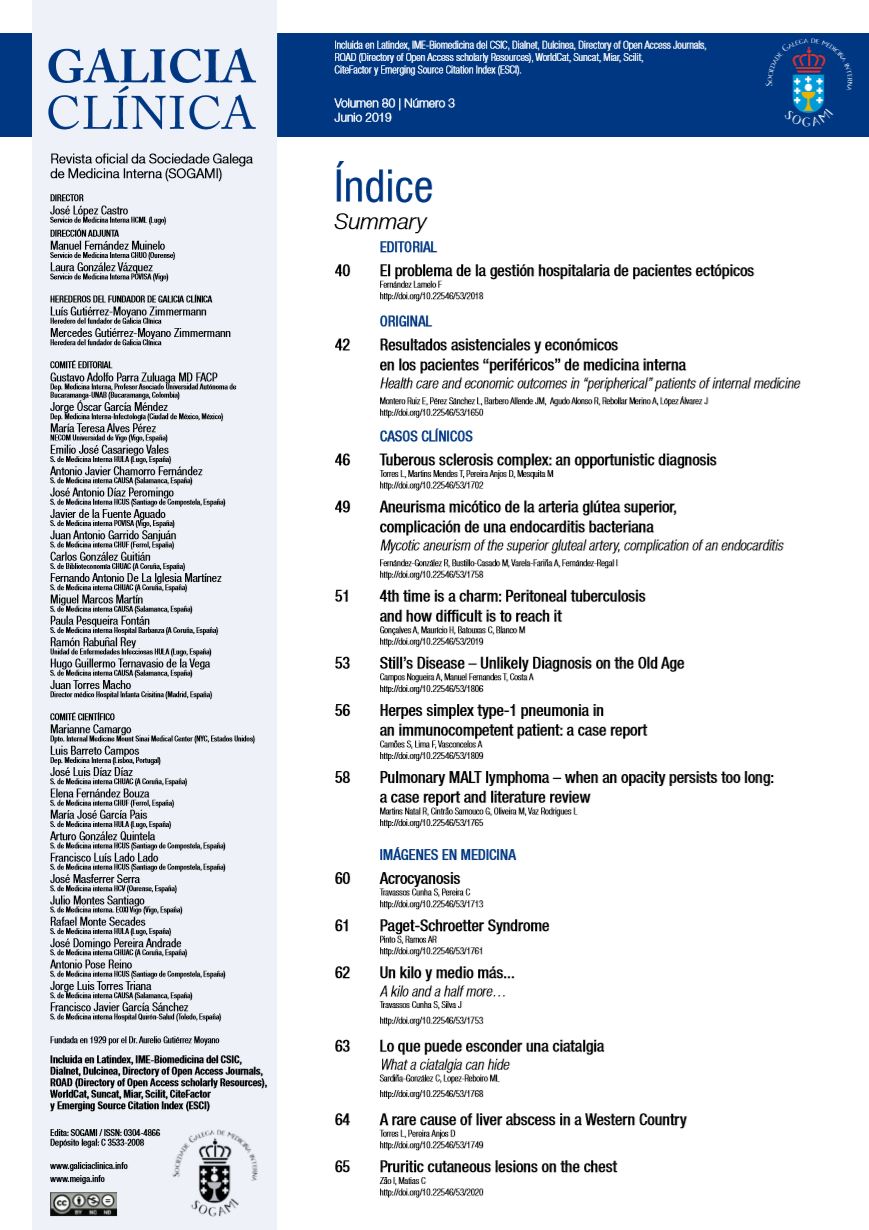Abstract
RESUMEN
Fundamento y objetivo
El sistema tradicional de organización hospitalaria asigna un número de camas consecutivas, en una o varias unidades de hospitalización (plantas), a los diferentes servicios. Esta distribución permite una organización estable y circunscrita espacialmente, pero facilita la aparición de pacientes “periféricos”.
Se analizó si los pacientes periféricos de Medicina Interna tienen peores resultados asistenciales y económicos que los ingresados en las camas propias del servicio.
Material y método
Estudio observacional retrospectivo que incluyó a los pacientes ingresados del 1 de enero al 15 de marzo y dados de alta antes del 1 de abril de 2015. Se compararon la estancia y mortalidad hospitalaria y los reingresos de los pacientes hospitalizados en las camas del servicio frente a los de los periféricos. Como variables de control se utilizaron la edad, sexo, número de diagnósticos al alta y el índice de comorbilidad de Charlson.
Resultados
Participaron 1045 pacientes, el 27,8% (IC 95% 25,1 a 30,6) periféricos. La mortalidad en ambos grupos no difirió significativamente (OR 0,8 [IC 95% 0,5 a 1,3]), pero sí los reingresos (OR 1,6 [IC 95% 1 a 2,5]; p=0,037) y la estancia media (1 [IC 95% 0,1 a 1,8]; p=0,034). Esto supuso un incremento del 51,2% en los reingresos y del 12,2% en la estancia. El exceso en la estancia originó un aumento del gasto en 157.703,3€.
Conclusiones
Los pacientes periféricos de Medicina Interna tienen unos resultados asistenciales peores que los hospitalizados en las plantas propias del servicio, con un incremento asociado del gasto.
ABSTRACT
Background and objective
Traditional hospital organization system assigns a consecutive number of beds, in one or more inpatient units, to the various services. This distribution allows a stable and spatially circumscribed organization, but facilitates the appearance of "peripheral" patients.
It was studied whether peripheral Internal Medicine patients had worse health care and economic outcomes than those admitted to their own beds.
Materials and methods
Retrospective observational study involving patients admitted from January 1 to March 15 and discharged before 1 April 2015. Hospital readmissions, length of stay and mortality of hospitalized patients in the beds of Internal Medicine Service were compared against the peripheral. Used as control variables age, sex, number of diagnoses at discharge and Charlson comorbidity index.
Results
The study included 1045 patients, 27.8% (95% CI 25.1 to 30.6) peripherals. Mortality in both groups did not differ significantly (OR 0.8 [95% CI 0.5 to 1.3]), but they did readmissions (OR 1.6 [95% CI 1 to 2.5]; p = 0.037) and length of stay (1 [95% CI 0.1 to 1.8]; p = 0.034). This represented an increase of 51.2% in readmissions and 12.2% in length of stay. Excess of hospitalization days has led to an increase in spending € 157,703.3.
Conclusions
Peripheral Internal Medicine patients have worse outcomes than inpatient care in their own beds, with an increase in associated costs.
© 2019 Galicia Clínica.
Complete article | Pdf article


